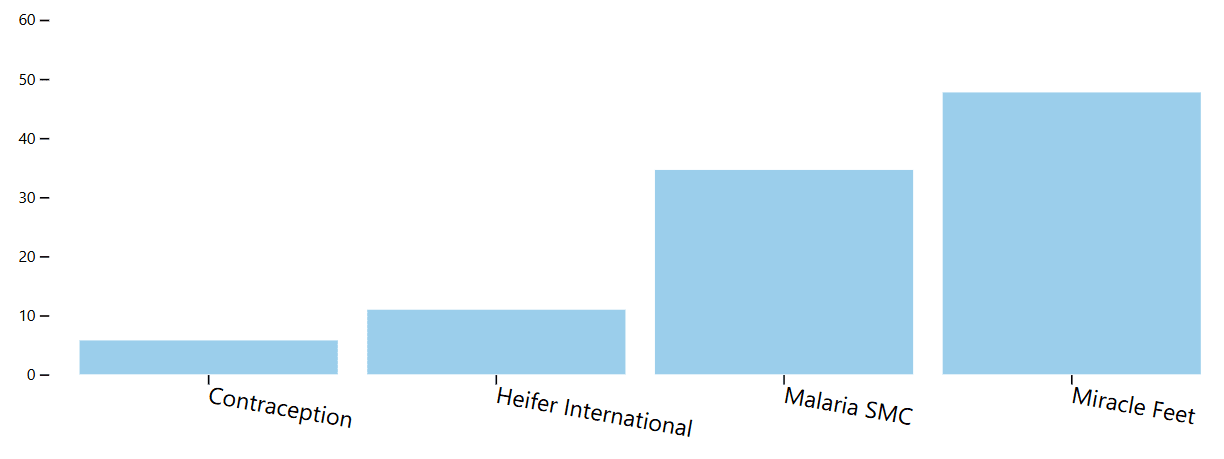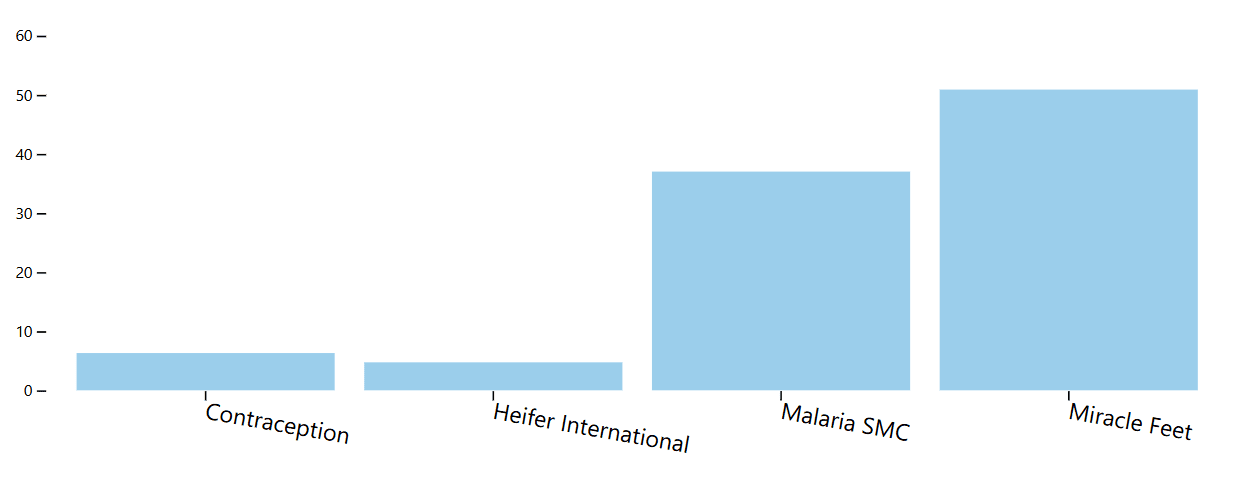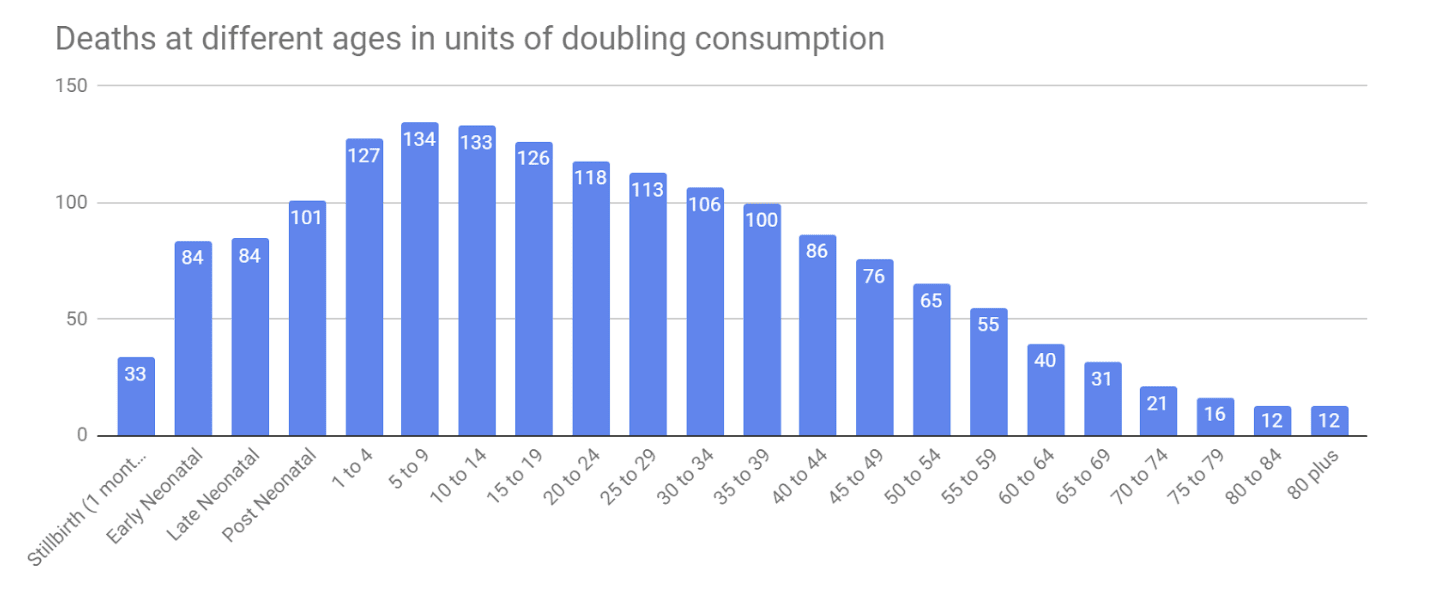A Moral Parliament Tool for Evaluating GiveWell Projects
By Hayley Clatterbuck @ 2025-10-15T20:26 (+14)
Executive Summary
- Our Moral Parliament Tool allows users to navigate normative, metanormative, and empirical uncertainty. It does so by representing diverse worldviews as delegates in a democratic decision-making process about how to distribute resources to various causes or projects.
- We have added functionality to the original Parliament Tool, which allows it to be adapted to novel resource allocation problems. In this series, we demonstrate the versatility and utility of the tool by applying it to analyze various types of problems.
Here, we present a parliament composed of delegates with different moral weights that decides how to allocate resources to GiveWell-evaluated global health charities. We consider the effects of including animal moral weights in GiveWell assessments.
Introduction
In this sequence, we explore how RP’s Moral Parliament Tool can be adapted to support deliberations about a range of resource allocation problems. In this post, we present a Parliament that decides on allocations across different global health charities evaluated by GiveWell. The key normative consideration is the moral weight assigned to different kinds of effects, including deaths at various ages, increases in consumption, and years lost to disability. Currently, GiveWell’s charity evaluations do not include an assessment of their impacts on animals. We have added the ability to confer moral weight on farmed animal DALYs and have included a charity that is not currently evaluated by GiveWell, but which has direct effects on farmed animals.
Many resource allocation problems involve navigating significant empirical, normative, and metanormative uncertainties. The Moral Parliament Tool offers a unified, user-friendly platform for navigating these uncertainties together. It allows you to easily test how changing the answers to any of these questions affects the overall results of deliberation. In the case we’ll consider here, users can test things like: what happens if I think that contraception projects will be much more effective than GiveWell estimates? What if I assign a higher weight to increases in consumption than they do? What would happen if we gave more voting power to stakeholders who put more weight on early childhood deaths?
GiveWell provides a helpful tool that allows users to answer some of these questions. Individuals can add their own moral weights, and the tool will calculate the resulting cost-effectiveness of several of their recommended programs. For those who want maximally precise customized cost-effectiveness estimates of GiveWell projects, we recommend using that tool. The Parliament has a somewhat different focus and makes two main contributions.
First, like GiveWell’s tool, the Parliament allows us to see how changing moral weight scores changes one’s assessment of GiveWell projects. However, it also allows us to aggregate and deliberate over multiple sets of worldview assignments, which will help us navigate disagreements within groups or uncertainty within individuals. As we will see, GiveWell aggregates across different stakeholders’ moral weights to arrive at its final moral weights. However, the process they use is quite limited, and the Parliament tool allows for a more expansive set of options that better capture moral disagreement. Second, it allows us to add moral weight dimensions that GiveWell does not currently consider. Here, we have included moral weights for farmed animal DALYs, allowing users to incorporate effects on non-humans into their evaluations.
GiveWell's moral weights and projects
Moral weights
Cause neutrality commits one to comparing interventions with very different outcomes. Moral weights are a mechanism for placing the value of different kinds of outcomes on a common scale. With moral weights in hand, we can assess the cost-effectiveness of different interventions in terms of the value gained per dollar spent. Researchers at GiveWell suggest that “Anyone deciding to donate to one charity over another is implicitly using moral weights, even if that person is not explicitly engaging with them.” Moral weights have been used to facilitate comparisons among:
- Lives saved from people of different age groups (e.g., saving x children vs. y adults)
- Different kinds of welfare improvements for a single group (e.g., doubled income vs. x additional years of life vs. y DALYs saved)
- Welfare effects on different species (e.g., improving conditions for farmed chickens vs. pigs)
Choices of moral weights can exert enormous influence on cost-effectiveness estimates. They can also be very difficult to set in a principled way. There are widespread disagreements about how the outcomes differ and which differences are most morally significant.
One way of handling disagreements about moral weights is to aggregate the views of different stakeholders. For example, GiveWell derives its moral weights for deaths at different ages from the following:
60% weight on donor responses
10% weight on James Snowden's 2018 weights (as a proxy for 2018 GiveWell staff)
30% weight on Years of Life Lost (YLLs), both as a commonly-used metric itself and as a proxy for the IDinsight survey
The Moral Parliament Tool can provide assistance in capturing disagreement about relative moral weights and in aggregating moral weight judgments through a broader variety of allocation methods. We believe this is valuable, as some methods of aggregation (e.g., taking the median response) may fail to represent all relevant stakeholders.
For example, GiveWell commissioned a report from IDinsight on the moral weights of people who resemble the target population of the projects under consideration. They found that a sizable proportion of survey respondents reported valuing lives lost very highly, compared to increases in consumption. Some respondents assigned a high dollar value to a life (e.g., $10 million), while others always prioritized lives saved, regardless of the monetary amount. There are reasons to doubt that these express genuine and consistent preferences.[1] However, suppose that there is a significant subset of people who do place enormous value on life, perhaps even believing that it cannot be traded off for income at any level. These delegates will have very little influence for some methods of aggregating across moral weights, such as taking the median of the population. For other aggregation methods, such as minimax, maximizing expected choiceworthiness, or approval voting, their voices could have a significantly larger impact on overall resource allocations. It can be challenging to determine which allocation method is normatively appropriate for specific problems. However, we believe our Parliament tool is valuable in illustrating the different results yielded by various aggregation methods.
Representing GiveWell weights and projects in the Parliament
We have created a Parliament (spreadsheet here) populated by delegates with different sets of moral weights, which allocate resources across four global health charities. Users also have the option of creating delegates to represent their own moral weights. For three of the projects (Malaria SMC, MiracleFeet, and Contraception), we used GiveWell’s own cost-effectiveness estimates to generate project scores. For a fourth (Heifer International), we used an outside cost-effectiveness assessment, as it is not a GiveWell-recommended project. Worldviews are sets of moral weights assigned to human deaths at various ages, human DALYs, doubled consumption, and farmed animal DALYs.
This parliament contains only one normative dimension, Moral Weight. A worldview assigns values that reflect the relative moral weight it assigns to the following categories:
- Death at different ages
- Doubling consumption for one person for 1 year
- Human Disability-Adjusted Life Year (DALY): a year lived with a health condition, in accordance with the condition’s disability weight from the 2019 Global Burden of Disease
- Animal DALY
GiveWell provides their moral weights across these categories, except for Animal DALYs, which are excluded from their cost-effectiveness estimates (so we attribute a moral weight of 0 to this category for the GiveWell worldview). A DALY is worth 2.3 units of doubled consumption.[2] They measure the value of deaths in terms of units of doubling consumption as follows:
The Parliament primarily operates on values from 0 to 1, with 1 indicating full moral weight and 0 indicating no moral weight, so we need to first adapt GiveWell’s moral weights to that scale.[3] The category that receives the highest moral weight is the death of a child between ages 5 and 9, so we set this moral weight to 1. This is equivalent to 134 years of doubled consumption, so it follows that the moral weight of a year of doubled consumption is 0.0075. Because a DALY is worth 2.3 times this amount, a DALY is worth 0.0172 in the parliament. The equivalent moral weights for deaths at other ages are:
| Age | GiveWell Moral Weight | Parliament's Moral Weight |
| Stillbirth | 33 | 0.246 |
| Early neonatal | 84 | 0.627 |
| Late neonatal | 84 | 0.627 |
| Post neonatal | 101 | 0.754 |
| 1to4 | 127 | 0.948 |
| 5to9 | 134 | 1 |
| 10to14 | 133 | 0.993 |
| 15to19 | 126 | 0.94 |
| 20to24 | 118 | 0.881 |
| 25to29 | 113 | 0.843 |
| 30to34 | 106 | 0.791 |
| 35to39 | 100 | 0.746 |
| 40to44 | 86 | 0.642 |
| 45to49 | 76 | 0.567 |
| 50to54 | 65 | 0.485 |
| 55to59 | 55 | 0.41 |
| 60to64 | 40 | 0.299 |
| 65to69 | 31 | 0.231 |
| 70to74 | 21 | 0.157 |
| 75to79 | 16 | 0.119 |
| 80plus | 12 | 0.09 |
To create other worldviews, we can change the relative moral weights across these categories. We have included three additional worldviews that make the following changes:
- YLL: Assigns moral weight to age categories proportional to their expected years of life left, assuming a life expectancy of 80 years.
- Income-focused: Assigns a 10x greater value to increases in consumption.
- Disability-focused: Assigns a 5x greater value to DALYs
- Farmed animal-focused: Assigns a moral weight to DALYs experienced by farmed animals, with the relative weight to human DALYs proportional to RP’s welfare range estimates
We then specified projects by their scale (how much value would they achieve if you assigned a value to 1 of everything they do)[4] and the proportion of their benefits that accrue to the different categories. For three projects, we specified values based on GiveWell’s own estimates of effects per $5 million investment:[5]
- Seasonal malaria chemoprevention: consortium that administers antimalarial drugs to children (GiveWell evaluation)
- MiracleFeet: philanthropy that corrects club foot deformities in children (GiveWell evaluation)
Contraception: programs (currently under evaluation) to increase contraception access in LMICs, with estimated price of contraception for one person for one year = $45[6] (GiveWell evaluation)
We also included a fourth project, which is not currently evaluated by GiveWell. Since we can estimate its direct effects on farmed animals, it helps to illustrate the effect of including Animal DALY weights:
- Heifer International: philanthropy that provides farm animals and training to low-income families (evaluation by Clements 2012)
Full project scores, along with brief explanations, can be found here.
Users who disagree with these project scores (either because they disagree with GiveWell’s estimates or our own interpretation of them) can easily change the Scale or normative dimension scores for projects in the web-based tool.
Selected results
Project scores by worldview
The worldviews (constituted by different moral weight judgments) rank projects in mostly predictable ways. Notice that MiracleFeet and Malaria score similarly on GiveWell’s moral weights, which makes sense as both pass their cost-effectiveness threshold. Contraception does not (at least at the cost level we assumed), which is reflected in the project scores. If we use Years of Life Left to assign moral weights to deaths at different ages, Malaria SMC receives a higher score as it primarily averts death at younger ages. Heifer International performs fairly well, even on GiveWell’s moral weights. It performs significantly better on worldviews that assign extra value to increases in income relative to death and disability, and it performs much worse on worldviews that assign moral weight to the experiences of farmed animals. This lends support to the hypothesis that GiveWell’s methods for evaluating charities could, in principle, recommend animal-based aid charities.
| Worldview | Project | Valuation |
| Givewell | MiracleFeet | 1299 |
| Malaria SMC | 1106 | |
| Heifer Intl | 826 | |
| Contraception | 454 | |
| YLL | Malaria SMC | 1387 |
| MiracleFeet | 1299 | |
| Heifer Intl | 826 | |
| Contraception | 473 | |
| Income-focused | Heifer Intl | 8183 |
| MiracleFeet | 3633 | |
| Malaria SMC | 3050 | |
| Contraception | 1086 | |
| Disability-focused | MiracleFeet | 5455 |
| Contraception | 1590 | |
| Malaria SMC | 1106 | |
| Heifer Intl | 826 | |
| Farmed animal | MiracleFeet | 1169 |
| Malaria SMC | 998 | |
| Contraception | 419 | |
| Heifer Intl | 366 |
Results of deliberation
We can now place representatives of each worldview into deliberations about how to distribute resources across projects. We will assume that projects have diminishing marginal returns.
Suppose that our parliament is entirely composed of people using GiveWell’s moral weights. The allocation that maximizes expected choiceworthiness (the overall amount of utility, weighted by worldview representation) gives most funds to their favored charities but also gives a substantial portion (~18%) to Heifer International.

Now, suppose we add an equal number of delegates who assign moral weight to farmed animal DALYs. Now, the allocation that maximizes expected choiceworthiness gives less money to Heifer International:

Moral Marketplace, which gives each worldview a proportional share of the budget to spend how they like, has similar results.
In contrast, if we use Maximin, we find the allocation that makes the worst off worldview as well off as it can be. The result is an allocation that gives even less to Heifer International:

We can see that assigning moral weight to farmed animal DALYs to GiveWell’s moral weights has potentially significant effects on allocation decisions. These effects are even more significant if we choose an allocation method like Maximin that avoids decisions that are disliked by some of the delegates.[7]
Conclusion
We intend the examples in this sequence as a proof of concept that the basic framework of the Parliament Tool can be applied to a diverse array of problems. We do not intend them as the final say in modeling these domains. Again, we caution that while we have tried to stay faithful to GiveWell's project estimations, we don’t claim to have captured everything that goes into their cost-effectiveness estimates. Further, Heifer International was not evaluated by GiveWell, so we can’t speak to whether they agree with those cost-effectiveness estimates.
We invite users to create their own moral weight worldviews and input their own project estimates. If you would like assistance in setting up a custom Parliament application for your organization or to make allocation decisions, please contact us.
Acknowledgments

The Moral Parliament Tool is a project of the Worldview Investigation Team at Rethink Priorities. Arvo Muñoz Morán and Derek Shiller developed the tool; Hayley Clatterbuck created the particular parliaments in this sequence. We’d like to thank David Moss and Urszula Zarosa for helpful feedback. If you like our work, please consider subscribing to our newsletter. You can explore our completed public work here.
- ^
GiveWell reports: “Overall, we don't really trust the results as providing a coherent and accurate picture of people's preferences. The questions were quantitatively complicated and very hard to answer, the sample size was limited for some of the questions, and social desirability bias may have played a major role in people's answers.”
- ^
For example, if a condition has a disability weight of 0.1, this means that a person living with the condition for 1 year loses 0.1 DALYs. This year of the condition is given a moral weight of 0.1 x 2.3 = 0.23.
- ^
It is possible to assign negative values or values greater than 1, but the Parliament operates most naturally over values of 0-1. While users can assign moral weights greater than 1, it is best to set the category with maximum moral weight to 1 (at most) and adjust the others relative to that value.
- ^
Since “fully value” means a value of 1 in the parliament, we simply add up the number of lives, disability years, and income contributions without weighting them by their moral weights. This might look misleading; if Project A saves 1000 lives and adds 1000 units of income, it has a lower scale than Project B which saves 0 lives and adds 3000 units of income. The lesson is to not read too much off of the Scale numbers since moral weights have not yet been applied.
- ^
We have tried to be as true to GiveWell’s project estimates as possible, but there are a few places where simplifications were used or where choices were made to disambiguate GiveWell’s values. We do not intend the Parliament’s project scores to capture full cost-effectiveness judgments, as we do not include adjustments for funging, etc. We can’t say how GiveWell’s evaluation of Heifer International would compare to the assessment that we used.
- ^
GiveWell provides a range of possible prices of contraception. They find that contraception initiatives are competitive with other recommended projects at a price under $20.
- ^
Indeed, regardless of the constitution of the parliament, Maximin will always give very little money to Heifer International as long as there are farmed animal-focused delegates.
